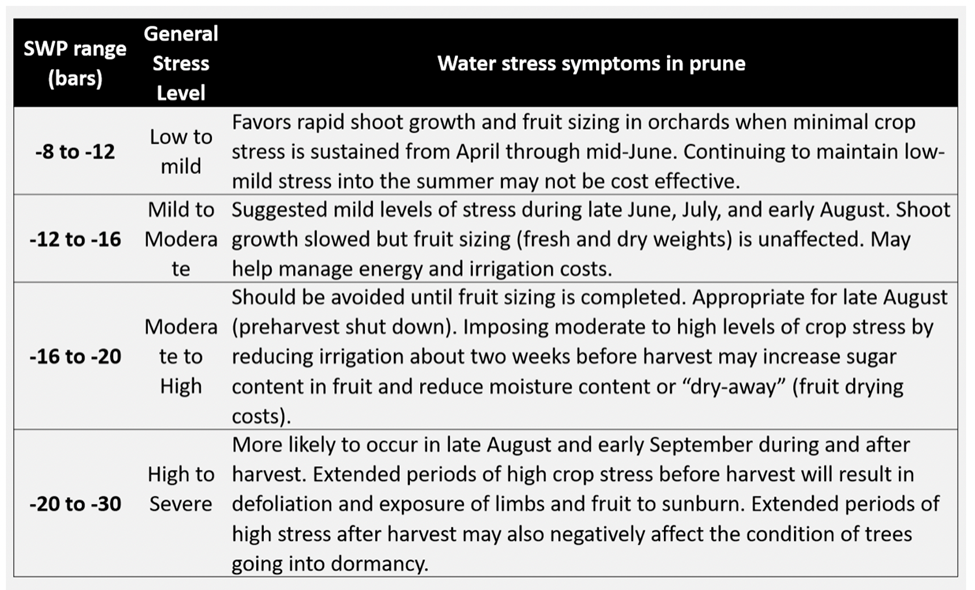Curt Pierce, UCCE Irrigation and Water Resources Advisor, Glenn, Tehama, Colusa, and Shasta Counties
While area production has been impacted by spring freezes and reduced water supplies, when considering late-season irrigation strategies for prune trees, both the current and following season’s crops must be considered. From June to mid-August, fruits are sizing and adding dry weight until they reach maturity at around 4lbs. pressure. This is also when prune trees are initiating both the floral and vegetative buds that will form the basis for next year’s crops. Even in years with heavy crop loss, producers should strive to maintain sufficient tree water status to maintain any current crop-load as well as overall tree and orchard health to help support crops in the coming years.
While ET and relative soil moisture are helpful for informing irrigation decisions, use of the pressure chamber is the best way to both directly measure the stress levels of trees, and account for local variations impacting different . From late June to early or mid-August, mild to moderate tree water stress levels of -12 to -15 bars allows for both sufficient support for the current crop (Table 1) and subsequent crop development while reducing overall water applied.

Table 1. Yield and production factors at different tree water stress levels in prune (Shackel et al., 2000) Shackel, K. A., B. Lampinen, S. Southwick, W. Olson, S. Sibbett, W. Krueger,and J. Yeager. 2000. Deficit irrigation in prunes: Maintaining productivity with less water. HortScience 35(6): 1063-1066.
Once fruit sizing has , further irrigation reduction down to approximately -20 bars may improve dry-away ratios with increased sugar and reduced moisture content (Table 2.) This can be achieved by stopping all irrigations in the week or two before harvest. Reduced water applications at this stage also helps to reduce premature fruit drop as well as bark injury due to shaker Producers with trees on K86 rootstocks, in particular, should be aware that extra dry down time may be needed for those trees to be adequately protected from possible bark damage. However, extended periods of increased tree water stress levels may negatively impact fruit bud development for the following year, as well as reducing potassium uptake. Increased levels of sunburn and Cytospora cankers can also occur with sustained water stress in prune. Follow-up checks with the pressure chamber can help ensure that trees remain near -20 bars and help avoid more harmful crop stress.
In cases where total crop loss has occurred, and/or water supplies are severely restricted, available water can be allocated evenly through the pre-harvest period, with a goal of more frequent, shallower irrigations to limit applied water to the bulk of the effective root-zone. Application of foliar zinc in the early fall can help initiate defoliation and further conserve available soil moisture.
Post-harvest irrigation targets should seek to return to tree-water stress levels of approximately -12 to -16 bars when sufficient water supplies exist to do so. This will help protect against sunburn and other negative effects heading into dormancy (Table 2.) Refer to our “Irrigating During a Drought – Scenarios” article for more information.



Leave a Reply